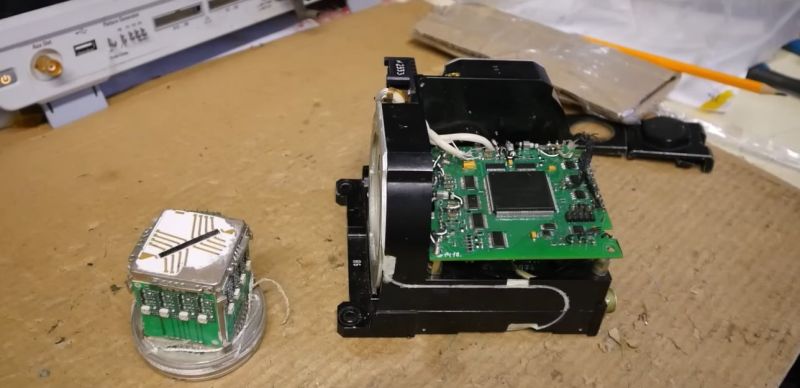Recently [Michel] received two packages from Ukraine containing some salvaged Russian electronics that once belonged to (presumably) a 9K38 Igla, Vympel R-27 or similar infrared homing missile, as well as a Fiber Optic Gyroscope (FOG) from an unknown missile, though possibly from the Tornado family of MRLSes. The latter uses the Sagnac effect to detect the phase shift between two laser beams being injected into the same fiber when the fiber, and thus the device, are rotating. The advantage of such a gyroscope is that it is effectively solid-state, requiring only some optical components, amplifier stage and as shown here an Altera Cyclone II FPGA to integrate the results.
The 16-channel linear infrared array sensor is more basic, with a matching amplification channel for each optical receiver element, which are fed into a multiplexer IC in a rather remarkable looking ceramic-gold packaged DIP format, with what looks like a 2004 date code (‘0424’). Although both are rather damaged, [Michel] figures that he might be able to restore the FOG to working condition, assuming no crucial and irreplaceable parts are missing. As useful as FOGs are in missiles, they also have countless uses outside of military applications.
Thanks to [Zane Atkins] for the tip.

















The FOG of war.
But can it play Crysis?
Hmmm…
We had a legacy product that used Altera Cyclone II FPGA’s in TQFP packages.
They suddenly became unobtanium about 3 months into the war. Right about the time we started hearing rumors in the supply chain that various governments had identifying certain western components in Russian weapons and were asking those vendors to kindly stop making these particular parts.
I noticed that chips in Altera MAX10 family which came in TQFP variants also got super rare or even impossible to find then too.
As far as I know, all of the Altera FPGAs were on short supply because Intel couldn’t make enough. They are probably still working through the backlog. Assuming they did it like everyone else, they would have done the high dollar ones first. It took them a while to fill the pipeline with Cyclone IIs, but the ones we were having a hard time getting in 2021 were available in late 2023.
We use what we were able to rip out of washing machines. =)
… and out of prototypes.
Prototype washing machines.
why does a washing machine need an fpga
Surely this remains property of the Kremlin? Isn’t this theft?
I suggest that – once the tear down is completed – it be reassembled and returned to the Kremlin.
At high velocity ;)
No, it was sent as an unwanted gift. But your right, such gifts should always be returned swiftly and accurately.
Oh no! I hope they aren’t angry. Better pack in lots of extra mass as an apology gift!
“As useful as FOGs are in missiles, they also have countless uses outside of military applications.”
Very, very bulky though.
This is an interesting tactic, outsourcing the expertise and allowing presence in the public eye to change the angle of the technological scale. Usually things like that don’t see the light of day long enough to go viral unless someone wants them to. Guess it’s deemed old enough or different enough from what everyone else has that the disadvantages are negligible.
Perhaps it’s interesting to note that he also has a video on the boards in a Javelin missile. One interesting thing is that there’s apparently no code aboard the missile. No storage at all. It probably gets programmed before the shot so nothing vulnerable or secret is shot in the direction of the enemy.
It raises interesting questions about how the other end is protected, because war is messy and unit will end up in enemy hands on way or another. There’s already a Russian Youtube channel examining and shooting captured weapon systems.
Either way, I’m amazed by the complexity of these systems considering the fairly single minded purpose they have.
I should add that the Javelin board seems significantly more complex than these, but that could be due to these being sensors and that being flight control.
Those javalins are also a quarter of a million bucks a piece for the missile.
What is ‘an op’ in this context?
I somehow don’t expect an answer.. NASA eh, sure sure, NASA. it’s an acronym too.
Thanks! Can you please mention the Russian youtube channel? It would be interesting to see teardowns of modern military systems.
Okay these are fun, I was tearing them down while on an op in Kyiv in jan of last year. Boy there’s a lot of cool teardowns I need to write but some are limited distribution. I have some Shahed INS parts on my bench and am getting some more weapons from this war to get into.
Definitely, that would be super interesting. Especially the Shahed INS teardown.